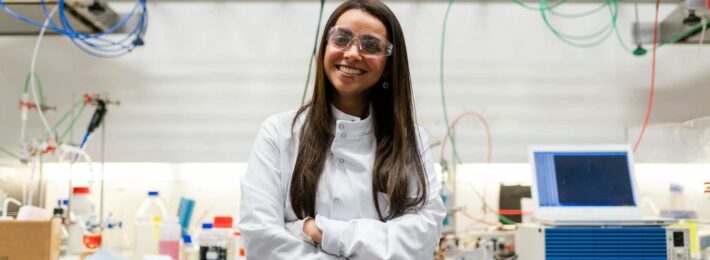
Re-opening academic labs for research is critical but fraught with opportunities for confusion, miscommunication, and risk. Representatives from an array of research institutions met recently in an Open Space virtual meeting to discuss solutions.
As a research professional in higher education, you are likely thinking about or in the process of relaunching operations after COVID-19 closures. You are coordinating to bring researchers back on campus, establishing guidelines for human subjects and animal research, and organizing communications to your stakeholders. Before you go further, have you considered consulting with others who are in your position or have already taken the next step?
On May 21, 2020, leaders in academic research from just under two dozen campuses met online to discuss the issues entailed, using an Open Space format to surface the most critical questions and working collaboratively to produce solutions. This virtual workshop was unique in its format, the second in an ongoing series of Group Collaboration workshops held by Academic Impressions. (You can read about the first in the series here.)
The Group Collaboration is a format you don’t usually see in a virtual professional development event; each of our virtual workshops provides an active learning environment where participants can explore ideas, get inspired by what their peers are trying, and get a sense of the wider range of possibilities in confronting a given problem. They leave the session with practical solutions they can take back to their team or task force.
In this case, the discussion was facilitated by Lindsay Lewis (Executive Director of Strategic Research Communications, University of Houston Division of Research) and Claudia Neuhauser (Associate Vice President and Associate Vice Chancellor for Research and Technology Transfer, University of Houston). The University of Houston was among the first institutions to resume research operations.
We’d like to share with you some of the key takeaways from this conversation among colleagues. Here are two of the questions that were addressed:
1. How do we know which safety measures are sufficient?
Many faculty express concern about coming back to campus. Some may be immunocompromised or have family who are, or may be concerned because of other risk factors. Fortunately—as one of our participants noted—the research labs are actually among the easier parts of the institution to re-open. Labs tend to be smaller and more isolated in their activities. With common areas and social gathering areas on campus closed, it’s easy to encourage researchers to go to their lab, complete their shift, and then go home. Reopening the campus to students and the broader community will be much more complex.
To further limit the risk, campuses re-opening to researchers could:
- Mandate health and safety training as a condition of the faculty application to return to campus.
- Ensure that PIs know they are responsible for setting shifts, maintaining social distancing, and sanitizing equipment and surfaces at the beginning of their shift.
- Require that researchers commit to checking their health each morning—and staying home if symptomatic.
- Provide an anonymous Environmental Health & Safety hotline that researchers can use to report safety violations.
- Consider regular EH&S checks on labs. (In the case of the University of Houston, if researchers are not wearing masks, they get two warnings of safety violation; after the third check, their privilege of campus access is revoked.)
- Limit contact between different shifts and groups. Researchers should remain on the same shift consistently. In animal research, researchers need to occupy separate shifts from the staff responsible for feeding, cleaning, and animal care. The objective is to keep the number of in-person interactions limited.
- Stress that any work that can be done from home still should be done from home.
- Make it clear that lab meetings should not be held in person—use videoconferencing.
To both address concerns and limit liability, work closely with general counsel on all faculty communications. Our participants agreed that it’s crucial to make two things very clear at the outset:
- Returning to campus is entirely voluntary, and PIs need to ask each of their lab members, very directly, if they are willing to return. Keep repeating that message—that this is voluntary.
- Make it clear you can’t promise that people won’t get infected with COVID-19 if they return to a lab. Stress personal responsibility for keeping the labs and one’s colleagues safe.
If researchers and staff are responsible and careful, it may be possible to keep the labs low-risk. It will be crucial to communicate that the health and safety of employees (and, later, students) is of the utmost importance to the institution.
2. How do we engage faculty in ongoing communication during a relaunch?
Regular and frequent communication is critical but also challenging. First, the opportunities for confusion are high. Communication from different stakeholders—from the president’s office to the research office—needs to be consistent and clear; institutions will need to be planful about their communications and avoid confusion or coordination across different messages to faculty. Second, at many institutions there are barriers to trust; faculty may see central administration as Big Brother, and during a crisis where many habitual freedoms are restricted, faculty may express distrust and frustration with the administration.
Brainstorming together, our participants proposed the following ideas:
- Website—Make sure all announcements and guidelines are clear and visible on one page; you don’t want faculty to have to search through multiple pages for the information they need.
- Weekly Q&A session—Hold a weekly, thirty-minute video call where faculty can ask the vice president for research pressing questions.
- Set up a platform for faculty to compare notes and raise questions—For institutions concerned about the “Zoombombing trend,” you can set up a Microsoft Teams site for your researchers and add Zoom as an app; you can then set up Zoom videoconferencing calls from within the Teams site. Other things you can do include creating different channels within your platform where researchers can raise questions on various issues, and where their peers and your staff can respond efficiently.
- Emails to faculty—Provide a weekly newsletter (sharing the results of the Q&A with the VP for research) as well as more frequent, quick updates more than once a week to address unexpected questions. The University of Houston provides a twice-a-week email, every Tuesday and Thursday, from the vice president for research.
- Repetition of guidelines—An initial health and safety training and guidelines posted in every lab are important steps, but not nearly enough. Our participants agreed that university expectations around health checks, social distancing, and PPE need to be repeated as frequently as possible, in each communication with PIs.
One example of a question one university hadn’t anticipated when relaunching was, “How do we ride elevators?” (Elevators do not allow for multiple people to maintain social distancing.) That’s just one example of a question that could come up during a relaunch. You won’t be able to anticipate and imagine every possible scenario, so it’s crucial to set up a conversational feedback cycle where faculty can raise questions and have them answered quickly, as well as brainstorm and share ideas and solutions with each other. This will reduce fear, promote the sharing of practical strategies, and build trust between colleagues and between faculty and administration—the kind of trust that will be increasingly critical if relaunching research operations is to be coordinated and safe.
Finally, our participants stressed the importance of coordinating official communications, especially during the initial prep to re-open research operations. For example, there may need to be an appropriate cascade of communications, starting with a letter from the president’s office, followed by clear instructions from the VP for research, followed by materials from HR, followed by updates as necessary from facilities and EH&S. What you don’t want to see is those communications going out in a random order or without coordinated messaging—that could lead to considerable confusion among the faculty. Adapting to an entirely new way of scheduling and coordinating research is stressful, and your faculty need both initial and continued clarity on what they need to do, what is expected of them, and where to submit questions and concerns.
Other questions addressed during this Group Collaboration included:
- What guidelines do we establish for field studies and labs?
- How can we most effectively use staggered shifts to allow for social distancing?
- How do we manage the passing of specimens between researchers?
- What happens after the first phase of re-opening?
It proved a vigorous discussion. We hope you’ll join us for the next!
_____________________________
Image credit: Photo by @thisisengineering at Unsplash.
Reopening Campus, Resuming Operations:
Participate in Virtual Events Like This One
Convening online—at a social distance—to address questions like these, and to share advice and strategies, is important. We plan to hold these expert-facilitated Group Collaborations regularly to address an array of issues faced by campuses planning to re-open.
Check our upcoming virtual workshops here


